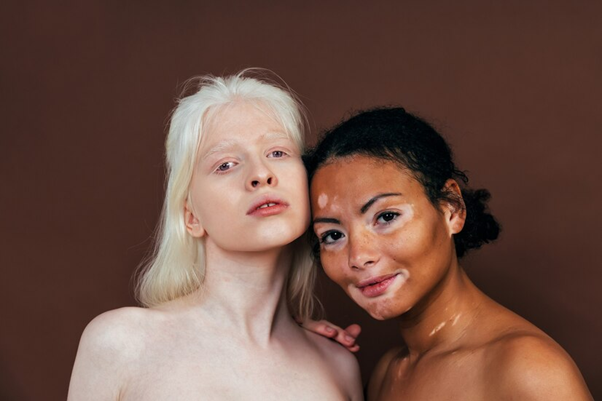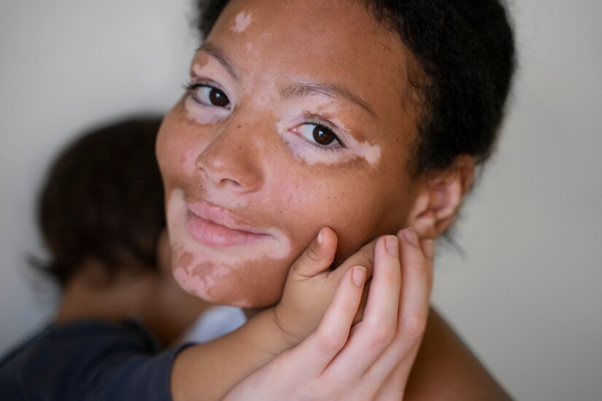Trichrome Vitiligo, a rare form of vitiligo, requires specialised treatment due to its unique appearance. It is characterised by three distinct skin colour changes: the normal skin colour, a completely white area, and a light-coloured area in between.
Dr. Archit Aggarwal, a dermatologist, explains that this condition can significantly impact the appearance of the skin, potentially leading to feelings of skin color abnormalities that can cause concern or distress.
Introduction

Trichrome Vitiligo appears as three different colours on the skin: the usual skin colour, a lighter patch, and a completely white area. This condition occurs when the skin cells responsible for producing colour malfunction. It can affect anyone and changes the appearance of the skin without harming your health.
Curious about the causes of trichrome vitiligo? Let’s explore together.
Trichrome Vitiligo Causes
Here are the causes of Trichrome Vitiligo:
- Immune System: Sometimes, the body’s defence system attacks its own skin cells that make colour, leading to Trichrome Vitiligo.
- Genetics: If your family members have vitiligo, you might be more likely to get it too.
- Stress: Both physical and emotional stress can trigger Trichrome Vitiligo.
Ready to explore trichrome vitiligo causes? Contact for expert insight.
Discovering trichrome vitiligo symptoms? Let’s explore together.
Identifying Trichrome Vitiligo Symptoms

To identify Trichrome Vitiligo
- Three Colours on Skin: You’ll see areas with your normal skin colour, lighter patches, and completely white spots.
- Common Areas: It often shows up on the hands, feet, arms, face, and lips.
- Changes in Hair Colour: Hair on affected skin might turn white or grey early.
- Mood Impact: While not a physical symptom, feeling worried or sad about the skin changes is common.
Exploring types of trichrome vitiligo? Let’s dive in together.
Trichrome Vitiligo types
Trichrome Vitiligo itself is a type of vitiligo characterised by three distinct colour zones on the skin.
However, when discussing vitiligo more broadly, it falls into different categories, including:
- Segmental Vitiligo (SV): Segmental vitiligo is localized to one or more dermatomal segments of the body, characterized by depigmented patches. It differs from generalized vitiligo in its restricted distribution pattern.
- Non-Segmental Vitiligo (NSV): This refers to the most common type of vitiligo where the white spots appear in a symmetrical pattern on both sides of the body. It is a slow but steady process.
- Universal Vitiligo: Universal vitiligo involves most of the body, characterized by widespread depigmentation. It affects a large portion, if not all, of the skin, differing from localized or segmental forms.
Trichrome Vitiligo appears as a pattern, mainly in Non-Segmental Vitiligo. Here, skin patches lose pigment at different levels. This results in three shades: normal skin colour, a paler patch, and a white area.
Curious about the types of trichrome vitiligo? Let’s explore together. Contact us for more information.
Trichrome Vitiligo Treatment Options
Trichrome Vitiligo treatment focuses on restoring skin colour balance and might involve:
- Topical Treatments: Colour correcting creams and ointments that you apply to your skin can, in this case, help. Such materials usually contain steroids or other drugs which are anti-inflammatory.
- Light Therapy: Light emitting diodes of particular wavelength might stimulate melanocytes to produce colour pigment again. It could be UV light in a doctor’s clinic or at home with a special desk lamp, for example.
- Medications:Some treatments slow down the immune system. This helps keep the skin colour changes from getting worse.
- Skin Camouflage: By using different cosmetic stuff like foundation or tanning products, people can cover-up the spaces where colours are different.
- Counselling and Support: Conversing with a counsellor or joining a support group can make you have a better image of your looks.
Doctors might combine these treatments to get the best results. It’s important to work with a doctor who knows a lot about skin to find the right treatment for you.
Ready to identify trichrome vitiligo symptoms? Contact for expert guidance.
Curious about managing lifestyle with trichrome vitiligo? Let’s discuss strategies together.
Lifestyle with Trichrome Vitiligo

Living with Trichrome Vitiligo involves both managing the condition and taking care of your emotional well-being.
- Protect Your Skin: Wear sunscreen daily, especially if you lack skin pigment, as it makes you more vulnerable to UVA rays. Opt for a very high SPF and remember to reapply it frequently.
- Gentle Skin Care: Choose gentle, moisturising soaps and lotions that are kind to your skin. Avoid products loaded with chemicals.
- Healthy Diet: Others discover that sticking to a diet rich in a variety of fruits and vegetables can be of aid to their skin. Taking plenty of water is similarly crucial.
- Cover Up or Camouflage: A special kind of makeup or clothes can be used to camouflage the blotches in case they make you feel insecure.
- Stay Connected: Join a support group or an online community of people who have vitiligo. Chatting with others, who you know feel the same way you do, is often very helpful.
- Exercise Regularly: Besides being good for the overall health, physical activity is often used for stress release.
- Mind Your Mental Health: It is natural to feel down about your skin which is a common situation. If they are strong enough and/or cannot be solved, therapy sessions can help.
Remember, every person with Trichrome Vitiligo has a unique experience. Finding what works best for you can take time, but it’s a valuable step toward living well with the condition.
Ready to embrace life with trichrome vitiligo? Contact for support and guidance.
Conclusion
Trichrome Vitiligo is a skin syndrome which makes your skin show three different colours. It can’t be cured, but you can manage it. Use sunscreen, eat healthy, and find good ways to deal with stress. Treatments and special makeup can help your skin look more even. Talking to people who understand can also make you feel better. Remember, you’re not alone, and you can still enjoy life with Trichrome Vitiligo.
FAQs
Why Trichrome Vitiligo Happens?
It’s when cells that make skin colour stop working or die. This makes some skin areas lighter or completely white.
Can Vitiligo Stop Spreading?
Yes, it can stop, but it’s hard to predict when. Sometimes it stops on its own or with treatment.
What is the root cause of Vitiligo?
It’s mostly thought to be an immune system mistake attacking skin colour cells. Genetics, stress, and sunburn can trigger it.
Is Trichrome Vitiligo Genetic?
Yes, it can run in families, but just because you have the gene doesn’t mean you’ll definitely get it. Environment matters too.

